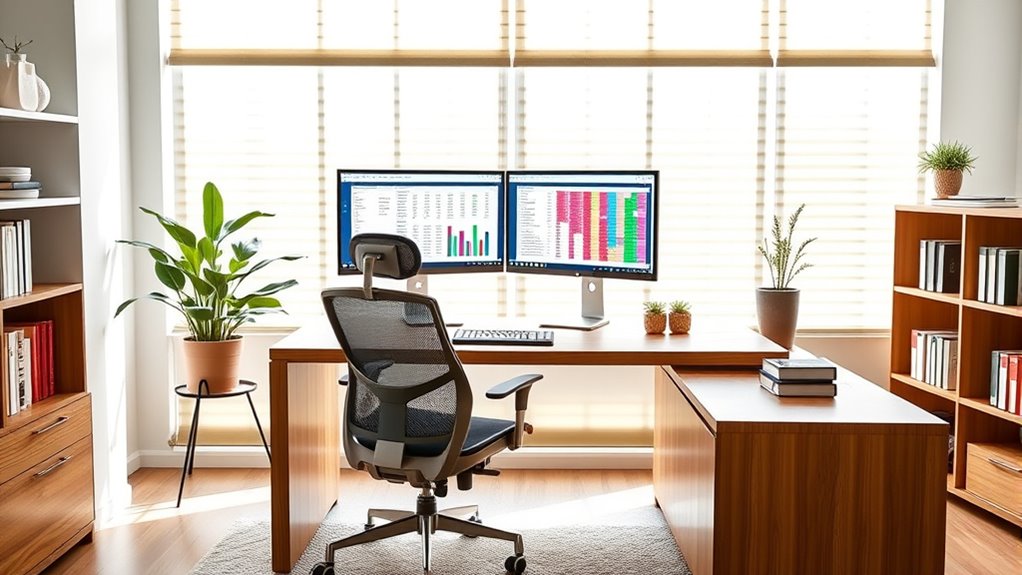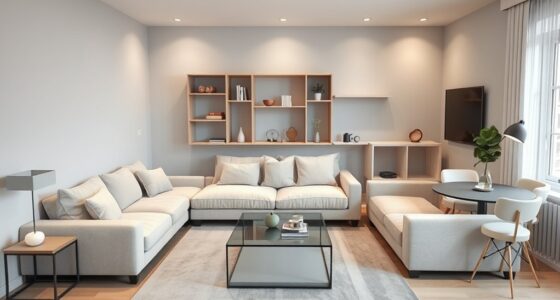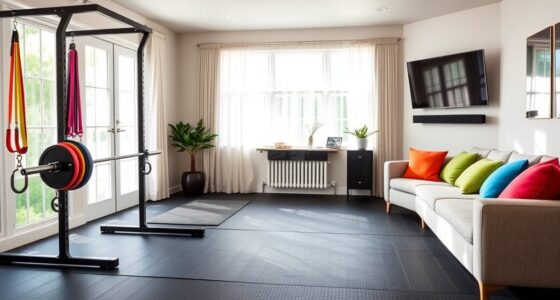To create a productive home office, start with ergonomic furniture like an adjustable chair and desk to keep you comfortable all day. Maximize natural light near your workspace and add layered lighting with desk lamps to reduce eye strain. Keep frequently used items within arm’s reach and organize cables to prevent clutter. Maintaining a dedicated, clutter-free area promotes focus. Explore these tips further to design a space that enhances your comfort and efficiency.
Key Takeaways
- Choose ergonomic furniture with adjustable features to support proper posture and reduce fatigue during long work hours.
- Maximize natural light and add layered lighting to enhance visibility and boost mood.
- Organize your workspace with frequently used items within arm’s reach and manage cables for safety.
- Position monitors at eye level and use adjustable lamps to minimize eye and neck strain.
- Dedicate a clutter-free, distraction-free area for focused work and regularly update your setup for comfort.

Are you wondering how to create a productive and comfortable home office? The key lies in designing a space that supports your focus and well-being. Starting with ergonomic furniture is essential. When you choose a chair that offers proper lumbar support and adjustable height, you reduce the risk of back pain and fatigue. Pair that with a desk that fits your working style—ideally one that’s at the right height to keep your wrists straight and your shoulders relaxed. Investing in ergonomic furniture might seem like a small step, but it can substantially boost your comfort, allowing you to work longer without discomfort.
Prioritize ergonomic furniture to boost comfort and productivity in your home office.
Lighting solutions are equally important. Natural light is best, so position your desk near a window if possible. It helps reduce eye strain and boosts your mood. However, if natural light isn’t enough or isn’t available at certain times, supplement with layered lighting. Combine ambient lighting, like ceiling lights, with task lighting, such as a desk lamp that directs light exactly where you need it. Opt for bulbs with a color temperature around 5000K, which mimics daylight and helps keep you alert. Avoid harsh fluorescent lighting, which can cause headaches and eye strain.
Creating a well-lit space means paying attention to glare and shadows as well. Use adjustable blinds or curtains to control sunlight and prevent it from reflecting off screens. Position your monitor at eye level to avoid neck strain and reduce glare from lighting. An adjustable desk lamp can help illuminate your workspace without overpowering the room’s overall lighting. Proper lighting not only improves visibility but also enhances your focus and reduces eye fatigue over long work sessions. Incorporating appropriate lighting can further optimize your workspace environment. Additionally, staying aware of regulatory considerations can help ensure your workspace meets safety standards and promotes a healthy environment.
In addition to ergonomic furniture and lighting, think about your overall setup. Keep frequently used items within arm’s reach to prevent unnecessary stretching or twisting. Use cable management solutions to keep cords tidy and prevent tripping hazards. Incorporating some greenery or personal touches can make the space more inviting, but avoid clutter, which can be distracting. Being mindful of environmental impacts can help you create a more sustainable workspace and reduce unnecessary waste. Moreover, considering health and safety standards ensures your workspace adheres to best practices for comfort and safety.
Finally, remember that your home office should be a dedicated space where you can focus without interruptions. Regularly assess and adjust your setup to ensure it remains comfortable and efficient. By prioritizing ergonomic furniture and effective lighting solutions, you create a workspace that not only looks good but also promotes productivity and health. This thoughtful setup will make working from home a more enjoyable and sustainable experience.
Frequently Asked Questions
How Can I Reduce Distractions in My Home Office?
To reduce distractions, focus on noise reduction by using noise-canceling headphones or soundproofing your space. Manage distractions by setting clear boundaries with family or housemates, and keep your workspace organized to minimize visual clutter. Turn off notifications and avoid multitasking to stay focused. With effective distraction management, you’ll find it easier to concentrate, boost productivity, and create a more peaceful, efficient work environment at home.
What Are Budget-Friendly Home Office Upgrade Ideas?
Think of transforming your space with a splash of creativity. You can brighten your home office with budget-friendly decor like colorful posters or stylish desk accessories. DIY organization ideas, such as repurposing jars or boxes, help keep clutter at bay without breaking the bank. These simple upgrades turn your workspace into an inspiring haven, making work feel less like a chore and more like a delightful daily adventure.
How Do I Choose the Right Ergonomic Chair?
When choosing an ergonomic chair, you want one that supports your ergonomic posture and has adjustable features. Look for chairs with adjustable height, lumbar support, and armrests to customize your comfort. Make sure it promotes proper spinal alignment and keeps your feet flat on the floor. Trying out different models can help you find the perfect fit, ensuring you stay comfortable and productive during long work hours.
What Lighting Options Improve Productivity?
Ever wonder what lighting secrets boost your focus? Natural light is your best ally, filling your space with energy and reducing eye strain. But don’t overlook task lighting—adjustable lamps that target your work area precisely. Combining these options creates an environment that energizes you and keeps distractions at bay. The right balance of natural and task lighting transforms your workspace into a powerhouse of productivity, unleashing your full potential.
How Can I Organize Cables and Tech Clutter?
To keep your workspace tidy, focus on cable management and tech organization. Use cable clips, sleeves, or cable boxes to bundle and hide cords, preventing clutter. Label your tech devices and chargers for easy access and troubleshooting. Regularly review and unplug unused gadgets to reduce congestion. Implementing these simple steps helps create a clean, efficient environment, boosting your productivity and making your workspace more comfortable and visually appealing.
Conclusion
Creating a productive home office boosts your efficiency and well-being. For example, Sarah reorganized her space with ergonomic furniture and dedicated quiet zones, transforming her workday. By customizing your workspace to fit your needs—whether it’s adding natural light or decluttering—you set yourself up for success. Remember, a well-designed office isn’t just about aesthetics; it’s about fostering focus and comfort, so you can thrive professionally from the comfort of your home.









